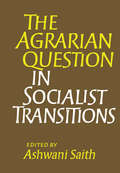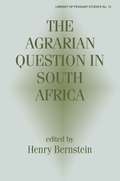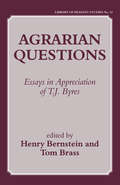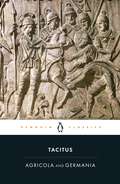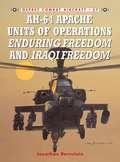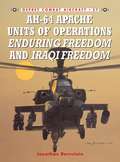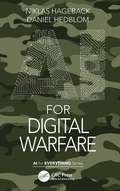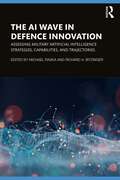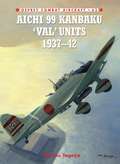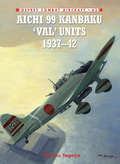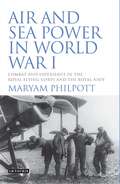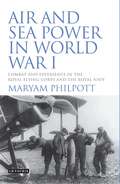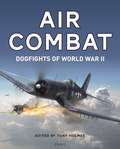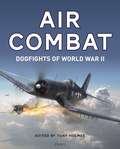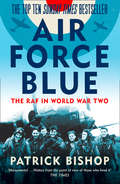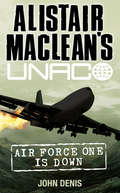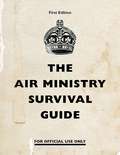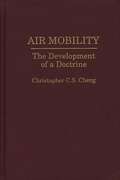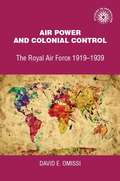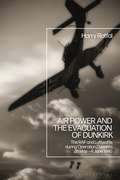- Table View
- List View
The Agrarian Question in Socialist Transitions
by Ashwani SaithFirst published in 1986. Routledge is an imprint of Taylor & Francis, an informa company.
The Agrarian Question in South Africa
by Henry BernsteinThis is the first collection of its kind. It presents a critical political economy of the agrarian question in post-apartheid South Africa, informed by the results of research undertaken since the transition from apartheid started in 1990. The articles, by well-known South African, British and American scholars, cover a variety of topical theoretical, empirical and policy issues, firmly rooted in an historical perspective.
The Agrarian Question in South Africa
by Henry BernsteinThis is the first collection of its kind. It presents a critical political economy of the agrarian question in post-apartheid South Africa, informed by the results of research undertaken since the transition from apartheid started in 1990. The articles, by well-known South African, British and American scholars, cover a variety of topical theoretical, empirical and policy issues, firmly rooted in an historical perspective.
Agrarian Questions: Essays in Appreciation of T. J. Byres
by Henry Bernstein Tom BrassThis collection celebrates T.J. Byres' seminal contributions to the political economy of the agrarian question. Uniting the various themes is the demonstration of the continuing relevance of a critical, historical and comparative materialist analysis of agrarian question.
Agrarian Questions: Essays in Appreciation of T. J. Byres
by Henry Bernstein Tom BrassThis collection celebrates T.J. Byres' seminal contributions to the political economy of the agrarian question. Uniting the various themes is the demonstration of the continuing relevance of a critical, historical and comparative materialist analysis of agrarian question.
Agricola and Germania: Edited On The Basis Of Draeger's Agricola And Schweizer-didler's Germania (Penguin Classics Series)
by Tacitus H. MattinglyThe Agricola is both a portrait of Julius Agricola - the most famous governor of Roman Britain and Tacitus' well-loved and respected father-in-law - and the first detailed account of Britain that has come down to us. It offers fascinating descriptions of the geography, climate and peoples of the country, and a succinct account of the early stages of the Roman occupation, nearly fatally undermined by Boudicca's revolt in AD 61 but consolidated by campaigns that took Agricola as far as Anglesey and northern Scotland. The warlike German tribes are the focus of Tacitus' attention in the Germania, which, like the Agricola, often compares the behaviour of 'barbarian' peoples favourably with the decadence and corruption of Imperial Rome.
AH-64 Apache Units of Operations Enduring Freedom & Iraqi Freedom (Combat Aircraft)
by Jim Laurier Jonathan BernsteinAfter the attacks on 11 September 2001, Apache units made significant contributions to the Coalition campaign against Taliban and al-Qaeda forces in Afghanistan. Functioning as the 'killer' part of US Army Hunter-killer teams, Apaches sought out and brought overwhelming firepower to bear on Taliban and al-Qaeda forces, as well as providing direct support to Coalition troops on the ground. Apaches spearheaded the advance of the 3rd Infantry and the 101st airborne divisions into Iraq, engaging in some of the heaviest fighting along the western axis of advance. Weather and enemy fire took a heavy toll on Apaches operating in Western Iraq, but the resilience and flexibility of the Apache was central to the success of this campaign.
AH-64 Apache Units of Operations Enduring Freedom & Iraqi Freedom (Combat Aircraft #57)
by Jim Laurier Jonathan BernsteinAfter the attacks on 11 September 2001, Apache units made significant contributions to the Coalition campaign against Taliban and al-Qaeda forces in Afghanistan. Functioning as the 'killer' part of US Army Hunter-killer teams, Apaches sought out and brought overwhelming firepower to bear on Taliban and al-Qaeda forces, as well as providing direct support to Coalition troops on the ground. Apaches spearheaded the advance of the 3rd Infantry and the 101st airborne divisions into Iraq, engaging in some of the heaviest fighting along the western axis of advance. Weather and enemy fire took a heavy toll on Apaches operating in Western Iraq, but the resilience and flexibility of the Apache was central to the success of this campaign.
AI for Digital Warfare (AI for Everything)
by Niklas Hageback Daniel HedblomAI for Digital Warfare explores how the weaponising of artificial intelligence can and will change how warfare is being conducted, and what impact it will have on the corporate world. With artificial intelligence tools becoming increasingly advanced, and in many cases more humanlike, their potential in psychological warfare is being recognised, which means digital warfare can move beyond just shutting down IT systems into more all-encompassing hybrid war strategies.
AI for Digital Warfare (AI for Everything)
by Niklas Hageback Daniel HedblomAI for Digital Warfare explores how the weaponising of artificial intelligence can and will change how warfare is being conducted, and what impact it will have on the corporate world. With artificial intelligence tools becoming increasingly advanced, and in many cases more humanlike, their potential in psychological warfare is being recognised, which means digital warfare can move beyond just shutting down IT systems into more all-encompassing hybrid war strategies.
The AI Wave in Defence Innovation: Assessing Military Artificial Intelligence Strategies, Capabilities, and Trajectories
by Michael RaskaAn international and interdisciplinary perspective on the adoption and governance of artificial intelligence (AI) and machine learning (ML) in defence and military innovation by major and middle powers. Advancements in AI and ML pose pressing questions related to evolving conceptions of military power, compliance with international humanitarian law, peace promotion, strategic stability, arms control, future operational environments, and technology races. To navigate the breadth of this AI and international security agenda, the contributors to this book include experts on AI, technology governance, and defence innovation to assess military AI strategic perspectives from major and middle AI powers alike. These include views of how the United States, China, Japan, South Korea, the European Union, and Russia see AI/ML as a technology with the potential to reshape military affairs and power structures in the broader international system. This diverse set of views aims to help elucidate key similarities and differences between AI powers in the evolving strategic context. A valuable read for scholars of security studies, public policy, and STS studies with an interest in the impacts of AI and ML technologies.
The AI Wave in Defence Innovation: Assessing Military Artificial Intelligence Strategies, Capabilities, and Trajectories
An international and interdisciplinary perspective on the adoption and governance of artificial intelligence (AI) and machine learning (ML) in defence and military innovation by major and middle powers. Advancements in AI and ML pose pressing questions related to evolving conceptions of military power, compliance with international humanitarian law, peace promotion, strategic stability, arms control, future operational environments, and technology races. To navigate the breadth of this AI and international security agenda, the contributors to this book include experts on AI, technology governance, and defence innovation to assess military AI strategic perspectives from major and middle AI powers alike. These include views of how the United States, China, Japan, South Korea, the European Union, and Russia see AI/ML as a technology with the potential to reshape military affairs and power structures in the broader international system. This diverse set of views aims to help elucidate key similarities and differences between AI powers in the evolving strategic context. A valuable read for scholars of security studies, public policy, and STS studies with an interest in the impacts of AI and ML technologies.
Aichi 99 Kanbaku 'Val' Units: 1937-42 (Combat Aircraft)
by Jim Laurier Osamu TagayaThe Aichi Type 99 Carrier Bomber (D3A) – code named 'Val' by Allied intelligence – was the mainstay of the Imperial Japanese Navy's carrier dive-bomber force from 1941 to 1943. It sank more Allied warship tonnage than any other Axis aircraft during World War 2. While the Val's participation in the major carrier battles has been widely covered in other English language sources, details of its operations have received scant attention in English. This book explores the Val's combat operations. Colour illustrations and photographs complement the development of dive-bombing methods in the IJN.
Aichi 99 Kanbaku 'Val' Units: 1937-42 (Combat Aircraft #63)
by Jim Laurier Osamu TagayaThe Aichi Type 99 Carrier Bomber (D3A) – code named 'Val' by Allied intelligence – was the mainstay of the Imperial Japanese Navy's carrier dive-bomber force from 1941 to 1943. It sank more Allied warship tonnage than any other Axis aircraft during World War 2. While the Val's participation in the major carrier battles has been widely covered in other English language sources, details of its operations have received scant attention in English. This book explores the Val's combat operations. Colour illustrations and photographs complement the development of dive-bombing methods in the IJN.
Air and Sea Power in World War I: Combat and Experience in the Royal Flying Corps and the Royal Navy
by Maryam PhilpottThe Great War tore the fabric of Europe apart, killing over 35 million men and challenging the notion of heroism in war, Air and Sea Power in World War I focuses on the experience of World War I from the perspective of British pilots and sailors themselves, to demonstrate that the army-centric view of war studies has been too limited. The Royal Flying Corps, created in 1912, adapted quickly to the needs of modern warfare, driven by the enthusiasm of its men. In contrast, the lack of modernisation in the Royal Navy, despite the unveiling of HMS Dreadnought in 1906, undermined Britain's dominance of the seas. By considering five key aspects of the war experience, this book analyses how motivation was created and sustained. What training did men receive and how effectively did this prepare them for roles that were predominantly non-combative? How was motivation affected by their individual relationship with weaponry development, and how different was defensive service on the Home Front, when in close proximity to ordinary civilian life?Finally, Air and Sea Power in World War I looks at the changing reputation of the services during and after the conflict, and the extent to which these notions were created by the memoirs of pilots and sailors. Featuring new primary source material, including the journals of service men themselves, this book will be essential reading for students and scholars of World War I and of Naval, Aviation and Military History.
Air and Sea Power in World War I: Combat and Experience in the Royal Flying Corps and the Royal Navy (International Library of War Studies)
by Maryam PhilpottThe Great War tore the fabric of Europe apart, killing over 35 million men and challenging the notion of heroism in war. Air and Sea Power in World War I focuses on the experience of World War I from the perspective of British pilots and sailors themselves, to demonstrate that the army-centric view of war studies has been too limited. The Royal Flying Corps, created in 1912, adapted quickly to the needs of modern warfare, driven by the enthusiasm of its men. In contrast, the lack of modernisation in the Royal Navy, despite the unveiling of HMS Dreadnought in 1906, undermined Britain's dominance of the seas. By considering five key aspects of the war experience, this book analyses how motivation was created and sustained. Featuring new primary source material, including the journals of servicemen themselves, this book will be essential reading for students and scholars of World War I and of Naval, Aviation and Military History.
Air Combat: Dogfights of World War II
by Tony Holmes Edward M. Young Aleksander Medved Dmitriy KhazanovThe battle for the skies in World War II fuelled a race between rival air forces to develop ever faster and more capable fighter aircraft – and the struggle for air superiority was never over until the war itself ended. This volume explores four clashes of some of the finest planes and pilots, in key theatres of the war: Spitfires duelling the formidable Bf 109 over the Channel, the Fw 190 battling the Soviet La 5 and 7 on the Eastern Front, the F4F Wildcat in a desperate clash with the legendary A6M Zero-sen, and the F4U Corsair in combat with the second-generation Japanese Ki-84 in the closing days of the war.Fully illustrated with contemporary photographs, maps and colour artwork, Air Combat conveys the full story behind these dramatic aviation duels.
Air Combat: Dogfights of World War II
by Dmitriy Khazanov Aleksander Medved Edward M. Young Tony HolmesThe battle for the skies in World War II fuelled a race between rival air forces to develop ever faster and more capable fighter aircraft – and the struggle for air superiority was never over until the war itself ended. This volume explores four clashes of some of the finest planes and pilots, in key theatres of the war: Spitfires duelling the formidable Bf 109 over the Channel, the Fw 190 battling the Soviet La 5 and 7 on the Eastern Front, the F4F Wildcat in a desperate clash with the legendary A6M Zero-sen, and the F4U Corsair in combat with the second-generation Japanese Ki-84 in the closing days of the war.Fully illustrated with contemporary photographs, maps and colour artwork, Air Combat conveys the full story behind these dramatic aviation duels.
Air Force Blue: The Raf In World War Two - Spearhead Of Victory
by Patrick BishopIn 2018 the RAF is one hundred years old. In his new book, destined to be a classic, Patrick Bishop examines the high point of its existence – the Second World War, when the Air Force saved the nation from defeat then led the advance to victory. A SUNDAY TIMES BESTSELLER
Air Force One is Down (Alistair MacLean’s UNACO)
by John DenisSomeone wants revenge, and the target is the President’s plane. When the mission looks impossible, the world calls upon UNACO.
The Air Ministry Survival Guide (Air Ministry Survival Guide)
by NoneTHE ULTIMATE SURVIVAL GUIDE for anyone who thinks they'd survive the world's most hostile environments - or at least imagine they could do.THE ULTIMATE SURVIVAL GUIDE for anyone who thinks they'd survive the world's most hostile environments - or at least imagine they could do.-----------------------------First issued to British airmen in the 1950s the beautifully illustrated Air Ministry Survival Guide provides invaluable practical tips and instruction on how to keep calm and carry on in any hostile environment.Whether you're lost in the desert, arctic, jungle, or adrift on the open ocean, you'll be better off armed with sensible advice on how to:- Build a structurally sound igloo- Pull faces to prevent frostbite (and when to expect bits to fall off should you fail)- Fashion a mask to prevent snowblindness- Make a hat out of seat cushions- Behave in the event of meeting hostile locals- Stay safe from poisonous reptiles and insects- Use a 'fire thong'- Punch man-eating sharks (which are cowards)
Air Mobility: The Development of a Doctrine (Non-ser.)
by Christop C. ChengIn the immediate post-World War II period, Army aviation began to evolve from an observatory role to a mobility role. Helicopter air mobility began to develop in the Army from 1949 onwards. The outbreak of the Korean war assisted and accelerated the acceptance of greater helicopter air mobility within the Army. The Eisenhower period was a golden age for Army aviation, with rapid and extensive developments in air mobility doctrine and tactics. There was also a strong research and development effort to overcome the initial technological lag. These developments allowed the formation of the first air mobile division in 1965 to meet the growing demands of the Vietnam war. This work gives a new understanding of the process of military innovation. Moreover, this case study has important general implications for future military policy-making.
Air power and colonial control (Studies in Imperialism)
by David OmissiAir policing was used in many colonial possessions, but its most effective incidence occurred in the crescent of territory from north-eastern Africa, through South-West Arabia, to North West Frontier of India. This book talks about air policing and its role in offering a cheaper means of 'pacification' in the inter-war years. It illuminates the potentialities and limitations of the new aerial technology, and makes important contributions to the history of colonial resistance and its suppression. Air policing was employed in the campaign against Mohammed bin Abdulla Hassan and his Dervish following in Somaliland in early 1920. The book discusses the relationships between air control and the survival of Royal Air Force in Iraq and between air power and indirect imperialism in the Hashemite kingdoms. It discusses Hugh Trenchard's plans to substitute air for naval or coastal forces, and assesses the extent to which barriers of climate and geography continued to limit the exercise of air power. Indigenous responses include being terrified at the mere sight of aircraft to the successful adaptation to air power, which was hardly foreseen by either the opponents or the supporters of air policing. The book examines the ethical debates which were a continuous undercurrent to the stream of argument about repressive air power methods from a political and operational perspective. It compares air policing as practised by other European powers by highlighting the Rif war in Morocco, the Druze revolt in Syria, and Italy's war of reconquest in Libya.
Air Power and the Evacuation of Dunkirk: The RAF and Luftwaffe during Operation Dynamo, 26 May – 4 June 1940
by Harry RaffalThe evacuation of Dunkirk has been immortalised in books, prints and films, narrated as a story of an outnumbered, inexperienced RAF defeating the battle-hardened Luftwaffe and protecting the evacuation. This book revives the historiography by analysing the air operations during the evacuation. Raffal draws from German and English sources, many for the first time in the context of Operation DYNAMO, to argue that both sides suffered a defeat over Dunkirk. .This work examines the resources and tactics of both sides during DYNAMO and challenges the traditional view that the Luftwaffe held the advantage. The success that the Luftwaffe achieved during DYNAMO, including halting daylight evacuations on 1 June, is evaluated and the supporting role of RAF Bomber and Coastal Command is explored in detail for the first time. Concluding that the RAF was not responsible for the Luftwaffe's failure to prevent the evacuation, Raffal demonstrates that the reasons lay elsewhere.
Air Power and the Evacuation of Dunkirk: The RAF and Luftwaffe during Operation Dynamo, 26 May – 4 June 1940
by Harry RaffalThe evacuation of Dunkirk has been immortalised in books, prints and films, narrated as a story of an outnumbered, inexperienced RAF defeating the battle-hardened Luftwaffe and protecting the evacuation. This book revives the historiography by analysing the air operations during the evacuation. Raffal draws from German and English sources, many for the first time in the context of Operation DYNAMO, to argue that both sides suffered a defeat over Dunkirk. .This work examines the resources and tactics of both sides during DYNAMO and challenges the traditional view that the Luftwaffe held the advantage. The success that the Luftwaffe achieved during DYNAMO, including halting daylight evacuations on 1 June, is evaluated and the supporting role of RAF Bomber and Coastal Command is explored in detail for the first time. Concluding that the RAF was not responsible for the Luftwaffe's failure to prevent the evacuation, Raffal demonstrates that the reasons lay elsewhere.
